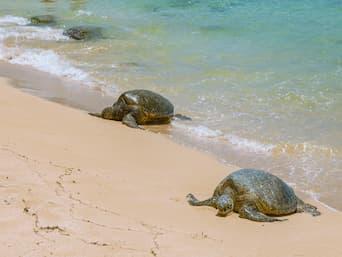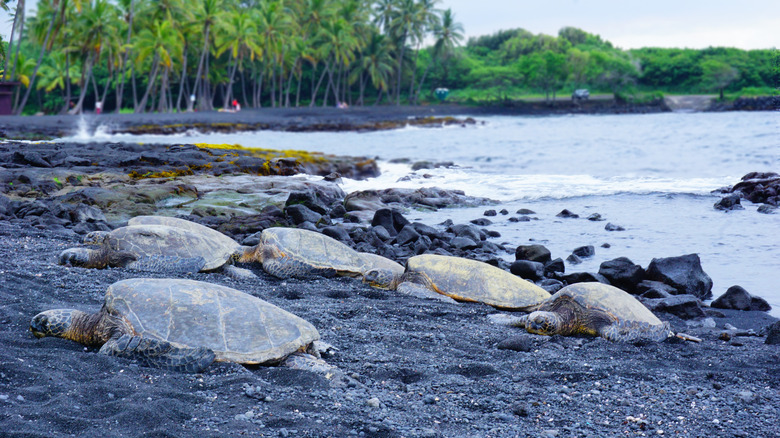
Hawaii’s Ancient Mariners: Navigating the Islands’ Premier Turtle Viewing Sanctuaries
Hawaii, a volcanic archipelago cradled by the vast Pacific, is synonymous with pristine beaches, lush landscapes, and a vibrant marine ecosystem. Among its most cherished inhabitants are the sea turtles, ancient mariners revered in Hawaiian culture as ‘Honu’—symbols of longevity, wisdom, and good fortune. For visitors, the opportunity to witness these majestic creatures in their natural habitat is often a highlight, a moment of profound connection to the ocean’s wild heart. This guide navigates the premier turtle viewing spots across the Hawaiian Islands, offering insights into where to encounter these gentle giants responsibly and respectfully.
The Hawaiian Green Sea Turtle ( Chelonia mydas ), or Honu, is the most commonly sighted species, a vegetarian grazer distinguished by its smooth, olive-green carapace. While other species like the critically endangered Hawksbill (Honu’ea) also inhabit these waters, the Honu dominates the viewing experience. These turtles are federally protected under the Endangered Species Act, making ethical viewing paramount. The golden rule: maintain a minimum distance of 10 feet (3 meters) from any turtle, whether in the water or basking on the sand. Touching, feeding, or harassing them is strictly prohibited and carries significant penalties.
Oahu: Where Urbanity Meets Ocean Wildlife
Oahu, the "Gathering Place," offers accessible turtle encounters, particularly on its iconic North Shore.
Laniakea Beach (North Shore): Affectionately known as "Turtle Beach," Laniakea is perhaps Hawaii’s most famous turtle viewing spot. Here, Honu frequently come ashore to bask in the sun, especially during mid-morning and late afternoon. The calm, shallow waters also provide excellent foraging grounds. Volunteers from Malama Na Honu (Turtles of Laniakea) are often present, educating visitors and ensuring the turtles’ safety by enforcing distance rules. "Laniakea offers an unparalleled chance to see Honu up close, but it’s a delicate balance," explains a local conservationist. "The sheer volume of visitors means we must be extra vigilant about protecting these animals from inadvertent disturbance." Parking can be challenging, and traffic heavy, so patience is key.

Hanauma Bay Nature Preserve (Southeast Oahu): This iconic marine life conservation area is renowned for its vibrant coral reefs and abundant fish, but it’s also a reliable spot for spotting Honu while snorkeling. The bay’s protected status means the turtles here are accustomed to human presence but remain wild. Booking a reservation well in advance is essential due to strict daily visitor limits designed to protect the fragile ecosystem. The clear, calm waters make for exceptional underwater viewing, often revealing turtles gracefully navigating the reef, searching for algae.
Electric Beach (Kahe Point Beach Park, West Oahu): For experienced snorkelers and divers, Electric Beach offers a unique encounter. Named for the warm water outflow from a nearby power plant, which attracts a diverse array of marine life, including numerous Honu. The turtles here are often larger and more active, drawn to the thriving ecosystem. This spot is less crowded than Laniakea or Hanauma Bay, offering a more serene interaction, though conditions can be rougher, making it less suitable for beginners.
Maui: The Valley Isle’s Turtle Haven
Maui’s pristine coastline and vibrant reefs make it a prime location for turtle encounters, particularly in its southern and western regions.
Maluaka Beach (South Maui): Often dubbed "Turtle Town," the waters off Maluaka Beach, particularly near the rocky outcroppings, are teeming with Honu. This area is a popular destination for snorkeling tours, but individual visitors can also swim out from the beach. The calm, clear waters make for excellent visibility, and it’s common to see multiple turtles feeding on the reef or gracefully ascending for a breath of air. "The coral gardens here provide a rich buffet for the Honu," notes a local dive instructor. "It’s a genuine privilege to share their space, watching them navigate their underwater world with such serene purpose."
Honolua Bay (West Maui): A marine life conservation district, Honolua Bay is a magnificent snorkeling and diving spot known for its vibrant coral formations and abundant marine life. While not a guaranteed turtle sighting spot like Maluaka, Honolua offers a high probability, especially further out in the bay. The turtles here tend to be less accustomed to human interaction, providing a more wild and authentic viewing experience. Access requires a short walk through a lush forest path, adding to the sense of discovery.
Black Rock (Ka’anapali, West Maui): Located at the northern end of Ka’anapali Beach, Black Rock is a popular snorkeling spot where the lava rock formation drops into deeper water. Honu are frequently seen here, particularly in the early morning or late afternoon, cruising along the reef or resting on the sandy bottom. It’s easily accessible from the beach, making it a convenient option for resort guests.
Big Island (Hawaii Island): Diverse Landscapes, Diverse Encounters
The Big Island’s varied topography, from volcanic deserts to lush rainforests, also extends to its marine environments, offering unique turtle viewing opportunities.

Kahalu’u Beach Park (Kona Coast): Just south of Kailua-Kona, Kahalu’u is renowned as one of the best snorkeling beaches on the Big Island. Its shallow, protected bay is a nursery for diverse marine life, including a resident population of Honu. The turtles here are often seen grazing on algae close to shore, making it an excellent spot for families and beginners. Educational signs explain the importance of reef protection and respectful viewing. "Kahalu’u is a living classroom," says a park ranger. "The turtles are a testament to the health of this reef, and we strive to keep it that way for generations to come."
Punalu’u Black Sand Beach (Ka’u District): On the southeastern coast, Punalu’u is famous for its striking black sand, formed by volcanic activity. More importantly, it’s a known basking spot for Honu. The dark sand absorbs more heat, providing a comfortable place for turtles to regulate their body temperature. It’s common to see several large turtles resting on the beach, often roped off by volunteers to ensure their safety and maintain the required distance. While swimming with them isn’t the primary activity here, witnessing these magnificent creatures against the stark black sand is a uniquely Hawaiian experience.
Kauai: The Garden Isle’s Secluded Sanctuaries
Kauai, with its dramatic cliffs and verdant valleys, offers more secluded and pristine turtle viewing opportunities.
Poipu Beach (South Kauai): A crescent-shaped beach consistently ranked among America’s best, Poipu is a reliable spot for Honu sightings. The calm, protected waters of the bay often host turtles feeding on the reef, and it’s not uncommon to see them pop their heads out of the water near shore. Monk seals also frequent this beach, adding to the wildlife viewing potential. Early mornings or late afternoons are often the best times for sightings.
Tunnels Beach (North Shore Kauai): For experienced snorkelers and divers, Tunnels Beach (Makua Beach) offers an expansive reef system with lava tubes and intricate coral formations. While more challenging to access and with potentially stronger currents, the reward is a truly immersive experience in a thriving marine ecosystem where Honu are frequently observed alongside myriad fish and other marine life. The natural architecture of the reef creates hiding spots and foraging areas that turtles find irresistible.
Responsible Viewing: A Pledge to Protect
Encountering a sea turtle in the wild is a privilege, not a right. Adhering to responsible viewing guidelines is critical for the turtles’ well-being and the sustainability of these experiences. Always:
- Maintain Distance: Stay at least 10 feet (3 meters) away from turtles on land and in water. This prevents stress and potential transmission of diseases.
- Do Not Touch, Chase, or Feed: Any interaction can alter their natural behavior and cause harm.
- Observe Quietly: Sudden movements or loud noises can startle basking turtles, causing them to return to the water prematurely.
- Use Reef-Safe Sunscreen: Chemicals in conventional sunscreens are harmful to coral reefs, which are vital habitats for turtles and their food sources.
- Pack It In, Pack It Out: Leave no trace of your visit. Marine debris is a major threat to sea turtles.
The Hawaiian Green Sea Turtle’s journey from near extinction to a recovering population is a testament to dedicated conservation efforts. Each respectful encounter contributes to their continued survival. Witnessing a Honu gliding through crystalline waters or resting serenely on a sun-drenched beach is more than just a tourist activity; it’s a profound reminder of the ocean’s delicate beauty and our shared responsibility to protect it. These ancient mariners, guardians of the Hawaiian seas, offer a glimpse into a world of timeless grace, an encounter that promises to linger long after the waves have receded.

